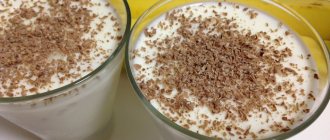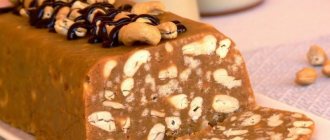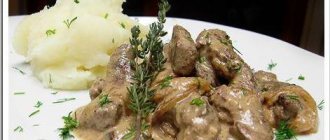Various varieties of nuts can make the taste of desserts and sweet dishes richer and richer, the aroma more refined, the appearance appetizing and attractive, and enrich the composition with a set of vitamins and microelements.
The product is introduced directly into the dough, used to decorate finished baked goods, and to give a complete look to a number of desserts. Various recipes include the use of raw and roasted, whole and crushed nuts.
Let's take a closer look at the most common types of healthy delicacies that have been highly valued since ancient times.
Walnut
A southern plant, the walnut, grows in Europe and Asia; high crop yields are also harvested in North America.
The fruit, shaped like a human brain, was considered “food for the mind” in Greece because it is rich in fatty oil, protein, carbohydrates, thiamine, rutin and ascorbic acid.
Walnuts are very popular in confectionery and cooking; even a small amount of this healthy product can improve the taste of many sweet dishes.
Walnut is perhaps the most accessible and widespread, since it is grown in our latitudes. They are used in the production of halva, pastries, cookies, cakes, and become an appropriate addition to desserts with ice cream.
Walnuts of milky ripeness will improve your health for many years!
Young nuts cleanse the blood and improve immunity; they are rich in vitamins and microelements. The maximum amount of ascorbic acid (about 2,500 mg) is contained in the fruit at the time when the green nut is so soft that it can be pierced with a needle.
In terms of vitamin C content, an unripe nut is 8 times higher than black currants and 50 times higher than citrus fruits. In addition to vitamin C, green nuts also contain vitamins P, E, group B, carotenoids, as well as phytoncides and quinines.
Young, green walnuts are a valuable source of natural iodine, which is necessary to compensate for the deficiency of this substance in the human body. The use of green walnut tinctures helps prevent the occurrence of thyroid diseases, as well as the appearance of goiter.
To increase immunity and normalize blood composition, you should mix equal parts of green nuts and honey, minced through a meat grinder, place in dry jars, leave in a tightly sealed container in a dark place for one month, shaking occasionally. Take one teaspoon 3 times a day 30 minutes before meals.
To prepare an alcohol tincture from green nuts, take 30 fruits and pour them with a liter of 70% alcohol. Leave to infuse for 2 weeks in a dark place, but at room temperature.
Next, don’t forget to strain the composition. Take the prepared medicine 3 times a day, 1 teaspoon. Tincture of green walnuts helps with diabetes, kidney, bladder, and thyroid diseases.
It is also used for disorders of the nervous system, poor blood circulation, for the prevention and treatment of cardiovascular diseases, and to cleanse the body of cholesterol.
Italians traditionally support their health with the bittersweet liqueur made from green nuts, Nocino. Nuts are collected for him on the night of June 24-25.
For Italians, the day of collecting green nuts became a national holiday - St. Giovanni's Day. They believe that it is at this time that the fruits are saturated with the maximum amount of useful elements.
“Nocino” has a good effect on digestion, so it is served after the main meal. The liqueur is drunk in its pure form, chilled at 16–18 °C, from 30–60 ml glasses and usually not eaten with anything, but if desired, the drink makes a good gastronomic pair with hard Italian cheeses and ice cream.
Hazelnut
The eastern coast of the Black Sea is considered the homeland of hazel. Hazelnut production is widespread in many European countries, the Caucasus, Asia Minor, Turkey, and the USA.
Hazelnuts are the basis for producing flour, paste, slices, candied, bleached, salted and chopped nuts.
Hazelnuts are the most balanced representative of nut-bearing fruits. It is an important component in cakes and desserts, and is indispensable in the production of chocolate, cream, and nougat.
You cannot do without hazelnuts when preparing the famous Kyiv cake, which has become the hallmark of the capital of Ukraine.
Peanut
Groundnuts from the legume family, originally from Brazil, are rich in fatty oils, easily digestible proteins, sugar, starch, gluten, vitamins B, D, E and do not contain cholesterol.
The fruits are a source of peanut oil for the confectionery industry, giving a unique aroma and original nutty taste to sweet desserts. Peanuts are added to cookies, cakes and other sweet dishes, and halva is made from it.
An exquisite delicacy - whole roasted peanuts covered with chocolate glaze. Without this nut, it is difficult to imagine the world-famous Snickers bar, a quarter of which consists of peanuts.
Why doesn't a nut bear fruit, and how can you make a tree bear fruit?
Walnut (Juglans regia) is a tall tree, up to 30 m.
It is characterized by:
- spreading crown with many branches growing at an angle of 90°;
- a root that spreads 40 m in diameter;
- leaves are odd-pinnate, compound, with entire edges, consisting of 5 leaves up to 7 cm long;
- flowers of green color: male in inflorescences-earrings; female single or collected in groups of 4, forming on the tops of annual branches, blooming for 16 days from April to May, pollinated by wind with pollen of trees of other varieties;
- fruits - false drupes that contain one four-lobed seed, which is covered with a thin film, with a peel up to 1.5 mm thick, ripening in September.
World walnut production is 2.1 million tons.
The United States consumes 150 thousand tons on the domestic market and exports 755 thousand tons to China, Hong Kong, and Vietnam. Chile produces 120 thousand tons and exports products to the EU and Turkey. The culture prefers fertile, drained soil. Life expectancy is more than 500 years. This plant quickly recovers after pruning the crown or frosting. Most varieties are unpretentious and resistant to cold.
Recommended reading
Description of the walnut and features of its cultivation
10 kg of drupes are collected from medium-yielding specimens. The yield of the plant increases with age to 25 kg.
Ideal is one of the most productive varieties. The harvest of a crop that has reached 20 years of age is 120 kg. The weight of the kernels is 10 g - this is half the weight of the fruit with the shell.
The ideal bears fruit already at the age of two, tolerates severe frosts, and is resistant to diseases.
The productive variety Giant with late ripening of large drupes weighing 30 g, bears fruit only in the fifth year, but grows quickly. The yield is 3 tons per hectare.
- The crop may not bear fruit due to the following reasons:
- The seedling is not yet ripe for fruiting. On average, a walnut begins to bear fruit after seven years of life; early varieties can bear fruit in the second or third year. From late varieties, the first harvest is harvested in the tenth year of the plant’s life. Seedlings grown by sowing seeds bear fruit no earlier than after 7 years; the first harvest from plants grafted from cuttings is harvested already in the 2nd year.
- Errors in agricultural cultivation technology or due to pest invasion.
- Lack of timely and sufficient watering during prolonged drought.
- The crown is thickened with many short growths.
- Densely planted trees quickly deplete the soil and begin to starve, resulting in a lack of fruit, vulnerability to disease and quick death.
- The seedling is planted too deep, so it develops poorly and does not bear fruit.
The recommended minimum distance between plants is 5 m, the optimal is 7–8 m. A close distance of 4 m is allowed on slopes.
Incorrect pruning
If a crop has many new shoots, they must be thinned out in order to ensure good fruiting. In particular, at the beginning of summer, dry and damaged growths and branches that interfere with the growth of other branches are cut off.
It is recommended to cut off thick branches not completely, leaving short branches. You should start pruning the side branches of a seedling at three months of age. To form the crown of a young specimen, skeletal branches are laid at the first level.
Another method of crown formation involves shortening the trunk at a height of 1.4 m after planting the seedling. Next, new growths at a height of up to 1 m must be cut off. Leave 3–4 side branches for the crown, growing in different directions, and the main conductor, which is cut to 0.70–1.0 m next spring to form the second level. Further pruning is carried out only by removing the crowns growing inward and damaged branches.
Did you know? China produces 1 million tons of walnuts and also imports about 70 thousand tons for the food industry.
No pollinator
To avoid uprooting or premature cutting down of a non-fruit-bearing tree that has reached the age of 12–15 years, it is necessary to find out the reason for this phenomenon.
First of all, take into account the biological characteristics of the selected variety, as there are:
- self-fertile forms, in which male and female flowers bloom simultaneously and self-pollinate;
- in protandric forms, self-pollination does not occur because male catkins bloom before female flowers;
- in protogynous forms, female flowers bloom before male catkin inflorescences, so self-pollination is impossible.
To ensure walnut yield, choose a self-fertile form.
For cross-pollination, trees of different varieties are planted nearby, this increases productivity and improves viability and compatibility when grafting seeds. The wind carries pollen over long distances, so most specimens can be harvested.
In large areas, trees are planted according to the following scheme:
- in the first 4 rows the protogynous form of nut is planted;
- then plant 1 row of the protandric form of the plant, and again alternate with 4 stripes of the protogynous form;
- Self-fertile or cross-pollinating varieties are planted in even stripes.
Experienced gardeners graft a cutting into the crown of a non-fruit-bearing crop or carry out budding with an eye from a specimen of another variety that blooms at the same time. If there is no pollinating plant, then the flowers are pollinated artificially - take a branch with ripe pollen and shake it over the flowers. The branch can be brought from another garden, the viability of the pollen remains for 30 days.
Read more about the characteristics of walnut ripening.
Another method involves laying out earrings indoors for a day in a layer on paper, the anthers of which open for ripening. The pollen is then collected in a gauze bag for later spraying.
A factor influencing the lack of fruits is freezing of early flowering plants with a long growing season. Specimens of a short growing season with later flowering and early ripening of fruits are very valuable, since the buds do not freeze and can be harvested annually.
The reason for the lack of ovaries may be cold rainy weather during the flowering period of the crop , which prevents the flowers from being pollinated. The pollen does not have time to ripen or dies. Dense plant stands do not allow the wind to blow through the crowns, so pollination does not occur.
"Fat" plant
The absence of fruits in walnuts is possible due to the active growth of young shoots without the formation of flowers. This phenomenon is called “fatification” of the tree. At the first symptoms, stop feeding the soil with nitrogen-containing fertilizers. An excess of nitrogen in the soil provokes “fatification”. Nitrogen feeding is contraindicated for young plants.
In addition, a high concentration of nitrogen in the soil can contribute to bacteriosis infection. If fattening continues, you should cut off the largest roots at a distance of 1.5 m from the trunk, after digging a ditch into the tree the width and height of a shovel. Then the soil must be backfilled.
We advise you to study the rules for feeding walnuts.
Almond
The nut, similar to an apricot kernel, is collected from bushes of the plum genus, cultivated mainly in the Mediterranean, USA, China, and Central Asia.
There are bitter and sweet almonds, the latter being more in demand in cooking. The nuts are sold peeled; to remove the shell, the almond grains are placed in boiling water for 1 minute before using.
Almond flour is used as a base for making marzipan. Pastes and fillers, natural flavorings in the form of essences that give a subtle aroma to cakes, are also made from almonds.
Almond petals are used to decorate various confectionery dishes. Almonds are often included in chocolate.
Cocoa paste is a natural product made from carefully selected, roasted,…
Cocoa paste is a natural product made from carefully selected, roasted, peeled and ground cocoa beans. According to historians, the first to taste cocoa were residents of the Gulf Coast. This was in such distant times and cocoa beans were so rare that they began to be used as local currency.
Compound
The chemical composition of cocoa beans is rich in all kinds of useful substances, of which there are already more than 300 today. Of these, the most beneficial for the human body are serotonin, tyramine, magnesium, histamine and others. Cocoa beans also contain large amounts of caffeine, organic acids, saccharides, cellulose, tannin and polysaccharides. It is the vitamin and mineral composition of cocoa beans that makes them so healthy.
Beneficial features
Africans have long believed in the medicinal properties of cocoa beans, using them for coughs and fevers, as well as for complications of pregnancy and childbirth.
The Aztecs used cocoa beans as an aphrodisiac, believing in their power, which was later proven by scientists who revealed a high content of phenylethylamine in the fruit. It is this substance that is called the “love drug” and it is what is produced in the brain when a person falls in love. Phenylethylamine affects the production of endorphin, which in turn improves mood, increases brain activity, reduces the risk of stroke, accelerates metabolism, which is also facilitated by flavonol and antioxidants.
Studies have also shown that regularly eating small amounts of products containing cocoa beans, such as dark chocolate or cocoa paste, helps lower blood pressure and reduce the risk of stroke, as well as heart disease, which is caused by blood clots and high levels of bad cholesterol.
The most interesting thing is that cocoa beans also contain phytonutrient antioxidants that help reduce fat levels and reduce body weight, which is achieved by accelerating metabolism.
Cocoa also increases vitality, efficiency and mental activity. Dark chocolate lovers are not afraid of stress, low tone and flabby old skin. Cocoa beans prolong life and protect health.
Application
Cocoa beans are used in various spheres of human life and activity. Cocoa beans are the most popular in confectionery and cooking, as their aroma and taste drive millions of people around the world crazy and this continues for thousands of years.
Pharmacists, cosmetologists and perfumers also appreciated the properties of cocoa beans.
Harm and contraindications
Want to know the secret to cocoa bean allergies? This is an allergy to chitin. Where does it come from? From the shell of cockroaches, which adore cocoa and infest it during transportation. When using beans in production, it is not possible to completely clear them of cockroaches, and their carcasses are ground with the beans, ending up in cocoa powder.
Cocoa itself does not contain a single component that can cause an allergic reaction.
Suppliers of cocoa beans treat containers with chemicals in order to exterminate cockroaches in the total mass of raw materials. First, the beans are sifted, then brushed and air purified in a cyclone, which removes stones, sand, sprouts and unripe beans.
During such processing, insect fragments rarely end up in powder and only when purchasing raw materials from unverified suppliers. Reputable companies and large production facilities monitor the sterility of cocoa beans, which avoids contamination and allergies to the final product.
Pistachios
Nuts - a symbol of the wealth of Ancient Persia - grow in the subtropics and tropical latitudes on shrubs and small trees. About 50% of pistachio fruits are now supplied from Turkey.
This is the only type of nut that contains lutein and zeaxanthin. There is copper and phosphorus, manganese and thiamine. Sweet dishes with pistachios are considered elite.
It is worth mentioning the famous pistachio ice cream. Pistachio kernels are added to halva and used in the production of sweets.
Pine nuts
Pine nuts have a bright, rich taste that is enhanced by the release of essential oils due to frying. Strictly speaking, what we are used to thinking of as pine nuts are actually pine pine seeds. The product is rich in phosphorus, iodine, vitamins A, B and E, proteins, and a number of amino acids (70% essential for the body).
A pinch of chopped nuts will add originality to the taste of desserts, cookies, or sweet pie.
Cashew
This fruit of a tropical tree spread from Brazil. The nut is grown artificially in India, West and South-East Africa, Vietnam, Iran, and Azerbaijan.
Confectioners value cashews for their delicate, buttery flavor, although they are less fatty than walnuts, almonds or peanuts. The nut is rich in minerals and is popular in the confectionery industry of the countries where it grows.
Ingredients
To prepare a delicious treat, you can use almost any nuts that you have on hand - almonds, hazelnuts, peanuts, hazel. One of the most popular and easiest is the recipe with walnut kernels. They harmoniously complement the taste, making it richer. If desired, you can add a spoonful of rum or liqueur - this will give the dessert an interesting, piquant note.
For preparation you will need:
- walnut kernels – 250 g;
- dark or milk chocolate – 220–250 g;
- milk – 100 ml.
Recently, instead of chocolate bars, confectioners are increasingly using callets - so-called chocolate drops or discs. They are easier to work with: they quickly acquire a liquid consistency and then set well!
Pecan
The southeastern United States is considered the homeland of pecans; the nut is also grown in Central Asia, the Caucasus, and Crimea. The kernels are similar in shape to walnuts, but softer and with a delicate taste.
Pecans, when eaten raw, complement sweet desserts. The most popular dish with nuts is pecan pie, a traditional delicacy for residents of the southern United States.
It is recommended to store pecans frozen because their high fat content can quickly turn bitter.
Recipes with chocolate covered nuts
Nuts in chocolate are an absolutely independent dish, so there are few recipes using them as an ingredient. Confectioners use such dragees most often for desserts.
Several recipes for confectionery using chocolate-covered nuts:
- Brownie with nut jelly beans
. Beat 100 g of butter with 300 g of granulated sugar (preferably brown). Add 2 chicken eggs to the resulting mass. In a separate bowl, mix 140 g of sifted wheat flour with 30 g of cocoa powder, a pinch of salt, 1 tsp. baking powder. Combine the liquid and dry mixture, mix thoroughly and add a few chocolate-covered nuts. Place the dough in a baking pan. Sprinkle the top of the dessert with glazed nuts. Bake for 25 minutes. Allow the dessert to cool before slicing. - Shortbread cookies with chocolate dragee
. Prepare the dough. To do this, mix soft butter (200 g) with 1 cup of cane sugar. Mix the ingredients until they become homogeneous. Add 2 chicken eggs, a pinch of salt and 1 tsp each to the oil. vanilla sugar and soda. Mix all the ingredients again and start kneading the dough. For this you will need about 250 g of wheat flour. Stir 100 g of chocolate-covered nuts into the dough (choose the smallest possible nuts). Form cookies from the finished dough. It is more convenient to do this by wetting your hands in water. Place the finished cookies on a baking sheet with parchment paper. Bake the dessert for about 25 minutes. - Chocolate cake with nuts
. Thoroughly beat 5 chicken eggs with 7 tbsp. l. granulated sugar. Beat until the mixture doubles or even triples in size. Grind 250 g of hazelnuts using a blender. Then, without mixing with the nut mass, grind 150 g of chocolate wafers. Add 2 tbsp to the nuts. l. wheat flour and cocoa powder. Add the resulting mixture to the prepared eggs. Bake the resulting dough in the oven for 50 minutes. While the cake is baking, prepare the cream: combine and thoroughly mix 200 g of melted but slightly cooled chocolate, 7 tbsp. l. Nutella and 200 g butter. Beat the resulting mass with a mixer. Cut the finished cake into two parts, coat with cream and sprinkle generously with crushed wafers (not only outside, but also inside the cake). Decorate the top cake of the dessert with chocolate-covered nuts.
Macadamia
The peculiarity of these nuts of Australian origin is the highest cost compared to other types, due to the duration of cultivation and the difficulty of obtaining - the macadamia shell is very durable.
The nut kernels have valuable nutritional properties and are similar in taste to hazelnuts. Roasted large fruits are covered with caramel and chocolate; small ones are added to desserts and baked goods, making them more refined and nutritious.











